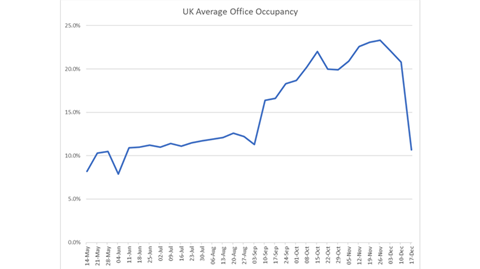Average office occupancy levels in the UK have fallen to new lows following the reinstatement of work from home (WFH) guidance as part of tighter Covid-19 restrictions to deal with the new Omicron variant.

Research carried out by Remit Consulting reveals that average office occupancy levels dropped by over 10 percentage points to 10.7% in the week ending Friday 17 December (from 20.8% the previous week). The decline was recorded a week after the government issued its WFH guidance on 8 December and marks the lowest occupancy rate since June.
The firm’s so-called Return Report is based on data provided by building managers from office buildings in major cities around the UK, many in central and prime locations.
‘The start of the school holidays and the Christmas break means the fall in the number of people working from the office was to be expected. However, the extent of the drop means that last week, there were fewer people in the office than during the summer holiday period,’ said Lorna Landells of Remit Consulting.’
She added: ‘This dramatic fall will be of worry to business occupiers and property owners alike, though not unexpected.
‘The mixed messages from the government, combined with the feelings of trepidation surrounding the Omicron variant, have caused further uncertainty for businesses and staff.’
Remit Consulting’s research on office occupancy also tracks the levels of car parking and visitor numbers for the buildings in the survey, both of which also showed sharp falls for the week ending 17 December.
Calls to work from home wherever possible have also been issued across many European countries as they grapple with the Omicron wave sweeping the continent.
This has prompted many big business to shelve office return initiatives which they had been rolling out since the end of the summer. It has also renewed the debate about the future of the office and whether occupiers will reduce their footprints as a result of permanent hybrid working.
So far, say office experts, there has been little evidence of a meaningful reduction in office space, with most of those occupiers which face a lease break opting for an extension until they have a better picture of their post-pandemic space needs.
John Mulqueen, head of offices EMEA at CBRE Investment Management and responsible for a €9.5 bn office portfolio across the region, told PropertyEU: ‘I think there’s a lot of speculation and lots of discussion around reducing floorspace, but we’re not seeing any real evidence of that in a significant way.’
Where possible, decisions on footprint are being deferred, he said. ‘We’re seeing lots of instances where people are asking for a one- or two-year extension to their lease where a break is coming up now. So requests along the lines of: can we have a bit more time to think please?’
He added: ‘Banks will reduce their footprint, they have been doing it for some time and will use this as a good moment to review their ways of working. But many other businesses, such as knowledge-based industries or creative clusters, are seeking more and better space.'










